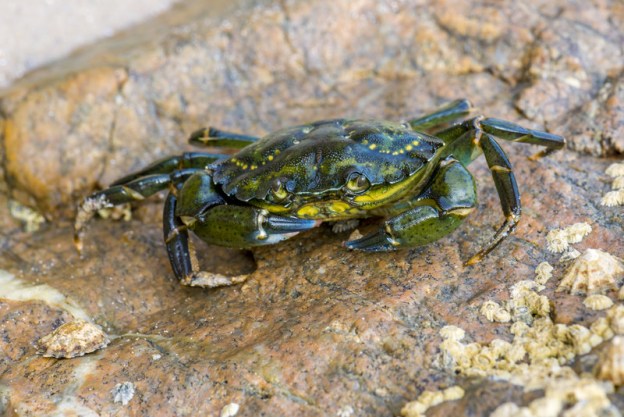While this crab may look like any other crab, there’s actually a few things that make it different from the rest. These differences have led this crab to be among the top ten least wanted animals in the world.
Background
The European Green Crab – Carcinus maenas – originates in Europe, hence the name, but is also native to the northeast Atlantic Ocean, the Baltic Sea, and coasts of North Africa, Norway, and Iceland. It enjoys living on rocky shores where it can easily hide from predators and find its prey, which also live in these rocks. Its predators include other crabs, birds, otters, seals, etc. This crab is an omnivore and will eat pretty much anything its size and smaller, like clams, oysters, mussels, marine worms, and small crustaceans. The Green Crab is known to consume the widest array of marine plants and animals known for any crab in the world. Although the crab is called green, it can also be grey, brown, red, or even blue. Adults grow up to 3 in. wide.
Invasion
The definition of an invasive species, according to the Convention of Biological Diversity, is a species whose “introduction and/or spread threatens biodiversity”. The European Green Crab could not suit this definition better.
The Green Crab can tolerate large ranges of salinities (4-52%) and water temperatures (0-30ºC or 32-86º F)–although it prefers warmer waters–allowing it to inhabit many different places. There are a couple sources of transportation that help the crab travel such as through natural means like waves, tides, ocean currents, etc. and through human-mediated transport like fish trade and marine vessels. On its mission to invade the world, the Green Crab has already invaded South Africa, Brazil, Australia, and both coasts of North America.
When the crab arrives in a new place it will quickly adapt to the climate and environment, calling it home within weeks. It will begin to search for food and with its highly aggressive behavior it will out compete the native fish and bird species, causing them to migrate if possible or in most cases die. Once the crabs are comfortable and have settled down in their new home the females will begin to lay eggs, laying up to 185,000 eggs at once!
Can you see what makes them so dangerous now? They can adapt to new environments quickly, travel efficiently, out compete native species, and reproduce at unbelievable rates.

